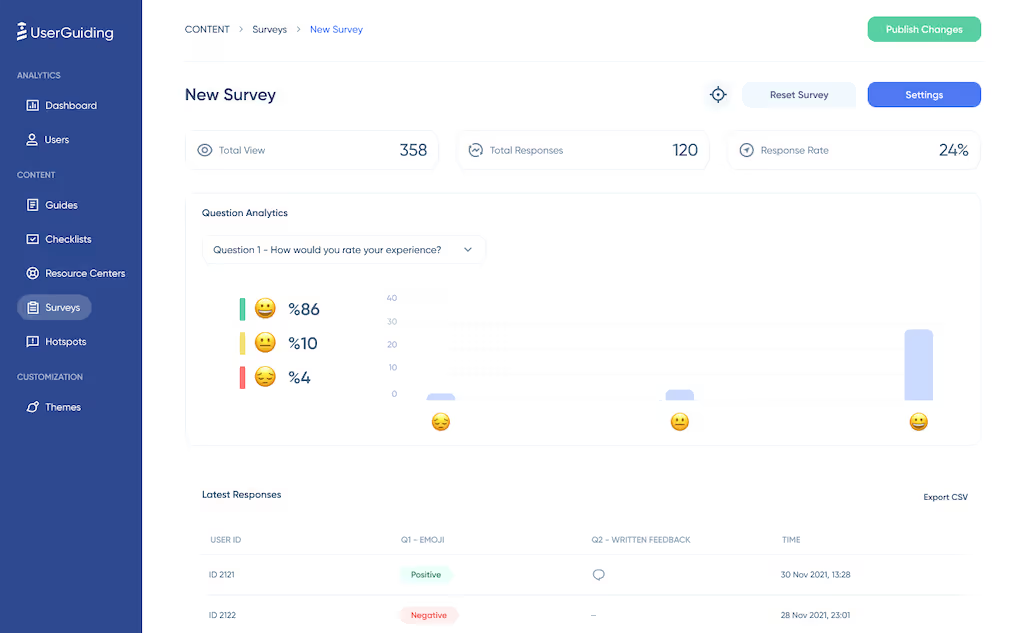

More and more companies are asking for feedback from their employees on a frequent basis to find out what they're thinking, moving away from the once-a-year survey to bi-annual, quarterly, or even monthly employee engagement meetings.
If you've never created an employee engagement survey before, this is the place to start.
Here you will find everything you need to know to make one for your company.
What is employee engagement?
Simply put, engagement is how someone thinks, feels, and behaves to help their organization reach its goals. An employee engagement survey, on the other hand, measures employee engagement so that you can analyze the data and take steps to improve the levels of engagement.
What factors impact engagement?
Employee engagement is measured using a five-factor composite score:
- Employees' intention to stay – the probability that they will stay with the company for the next two years.
- Work involvement - people's psychological and emotional investment in their work.
- Discretionary effort – above the minimum level of effort required that people are willing to put into their work
- Pride in the company – the degree to which employees are proud to work for the company.
- Willingness to recommend the company – how likely are people to tell their friends and family about the company?
Each of these items provides a score that, when combined, gives an overall metric of employee engagement.

Where to start with the survey design
To produce the best possible results and data, designing an effective employee engagement survey requires careful consideration. To begin with, keep your survey's structure simple and straightforward. Employees must understand how to respond to the questions, and managers must understand how to read the report.
Your goal is to ensure that as many employees as possible understand and act on the results of your employee engagement survey.
Here are some other things to consider before you get started:
- Decide who you need to include and who you don't need to include in your input (manage expectations by explaining why you are not consulting them)
- From the beginning, establish clear deadlines and turnaround times
- Request that participants notify you in advance if they are unable to meet the deadline so that you can assign someone else. Put one person for the final sign off, and make it clear to everyone involved in the sign-off process that when they say it's done, it's done
- Distinguish between "good to have" and "must have" questions
- Don't let a committee design your survey
- Determine when you will collect the feedback.
Work is digital and remote now, so how do I collect timely feedback?
You could be reading this from your home, from the nearest coffee shop, or from the beachside (🤫 we all did it).
And we all know that while platforms such as Teams or Slack make remote communication easier, it is not the same as walking to the next table and asking your colleagues a question.
The same goes for feedback.
Not everyone is comfortable with sharing what they want to say on a channel or digital group.
And it is not efficient to ask all employees to fill out a Google form every time there is something new going on.

Don't worry.
We made this process easier for employers, managers, and employees.
UserGuiding now offers advanced (but easy-to-use) surveying capabilities.
With UserGuiding, you can not only onboard and engage new employees faster and easier, but you can also collect any kind of feedback and conduct any kind of survey easily.

Do you need how your team found the new CRM system?
Ask them through UserGuiding's star rating survey, or thumbs up-down survey, along with a feedback question.
Do you need to know how satisfied other teams are with your collaboration performance?
Let them rate it through 1-5, 1-10, or multiple choice surveys right on the collaboration platform you use.
Make the questions and the feedback system accessible everywhere, on their onboarding checklist, on the resource center, or directly on the screen.
UserGuiding's price starts from $174/month for all features and fast customer support.
What questions to ask your employees
Your employee engagement survey should not only help you in resolving an issue at your company, but also highlight what you're doing well in the eyes of your most engaged employees. To do so, you must be sure that your survey questions will provide valuable information.
Don't worry if you're having trouble coming up with the right questions. When you create your own survey, you don't have to ask questions in a certain way to fit into a model; instead, each question can be tailored to be completely unique to your business, making your survey shorter and easier to digest.
Three key areas should be addressed in your questions:
- Engagement – these questions should be at the top of the survey and assess things like intent to continue, job commitment, discretionary effort, confidence in the business, and willingness to recommend the company
- Core themes - Questions about autonomy and empowerment, career advancement, teamwork, communication, leadership, visibility, resources, strategy, management support, and training and growth
- Additional topics – depending on what's going on in your business or industry, you may want to inquire about additional topics. To keep your survey from being too unwieldy, avoid including them all and just ask them if they're necessary
The next step is to determine which themes you want to measure and then develop questions to support those themes. As a general rule, ask 30-50 engagement-related questions to your employees.
Here are some questions you can use when creating your own survey.
Autonomy / EmpowermentAre people in their jobs empowered and able to innovate?Career DevelopmentAre there any opportunities for people to grow and develop in the company?CollaborationIs it easy for them to collaborate with other teams or colleagues without encountering any obstacles or conflicts?CommunicationAre they getting enough information from the company on what's going on, and do they feel heard?Company LeadershipDo employees believe in and trust their senior leaders?RecognitionDo people feel that they are valued and recognized?ResourcesAre they able to do their job with the equipment they've been given?Strategy AlignmentDo they believe in the company's direction and their part in it?Supportive ManagementAre managers supporting their teams in achieving success?Training and DevelopmentDo they believe they have received the necessary training to perform their jobs?Customer FocusAre they working in a customer-focused company where they have the freedom to do what's needed to be done?Diversity & InclusionDo they believe the company is fair and welcoming to all employees?Pay & BenefitsDo people believe they are fairly compensated for their efforts?Quality of Product or ServicesDo people believe in the products they (and/or the company) offer to their customers?SafetyDo employees believe their protection is important to the company?Social ResponsibilityDo they think the corporation is a good corporate citizen working for a good cause?Work-life BalanceDo they believe the organization helps them find the right balance between work and personal life?
Tip: We suggest using a 5-point Likert scale for all elements in employee engagement surveys, since this is the industry standard:
- Agreement Scale: Strongly Agree to Strongly Disagree
- Rating Scale: Very Good to Very Poor

Sample engagement survey questions
These sample questions will assist you in determining your employees' current level of satisfaction. You'll note that the questions cover many of the above-mentioned main engagement themes.
- In your current job, how satisfied or dissatisfied are you with what your position involves?
- In this role, how satisfied or dissatisfied are you with your ability to apply your skills?
- What level of satisfaction or dissatisfaction do you have with your current workload?
- How pleased or disappointed are you with your career development opportunities?
- How satisfied or dissatisfied are you with your workplace's physical environment?
- How happy or unhappy are you with the relationship with your manager?
- Are you pleased or disappointed with your current employer in general?
Your engagement survey checklist
When it comes to measuring employee engagement, each company will have its own needs. We've built a survey template and outlined the steps to get your employee engagement survey up and running, to make the process go more quickly.
- Use our free employee engagement survey template to get started.
- Determine who will be in charge of content review and approval. Although content should be reviewed by many individuals and teams, it should not be approved by more than one leader. When you have a final question collection, this will help you eliminate lengthy sign-off procedures.
- For everyone involved, establish clear deadlines and turnaround times.
- When prioritizing issues, include key leaders. To better understand organizational needs, gather feedback and suggestions from stakeholders. What do your company's leaders really need from their employees in order to be successful?
- Review and alter the engagement categories as needed. Remove those that you don't believe are important for your company and add any new ones you'd like to see.
- Review the questions in each of the remaining categories.
- Distinguish between "good to have" and "must have" questions, and tailor the questions to your company’s specific needs. In each category, keep at least three questions.
- In your survey, make sure to include all the necessary definitions. Many businesses, for example, define terms like "Your Manager," "Your Team," "Senior Leadership," and "This Organization" to ensure that everyone responds in the same way. These may be shown at the start of a survey or as people hover over questions, depending on the survey vendor.
- Submit your survey for approval and review. Expect at least two weeks for two or three rounds of iteration.
- Run your survey!
Tip: To get the most feedback, make sure to invite everyone in your company to participate and keep track of response rates. To give people the best chance to respond, keep the survey open for two to three weeks.

















.svg)
.svg)
.svg)
.svg)
.svg)

.svg)
.svg)












.svg)
.svg)




.png)

















